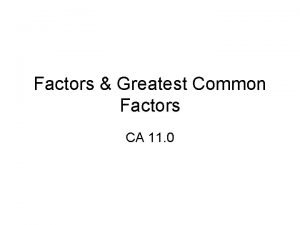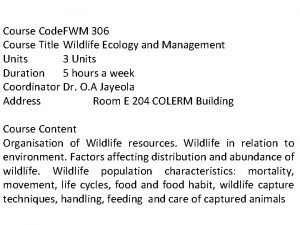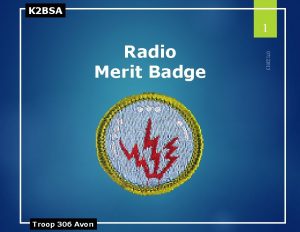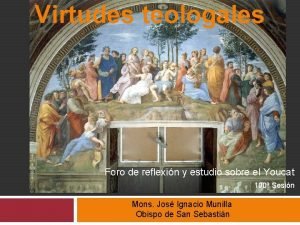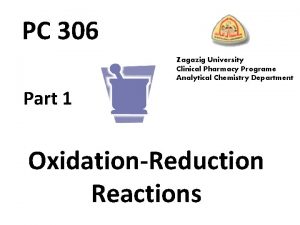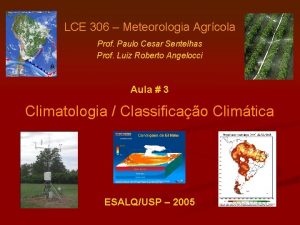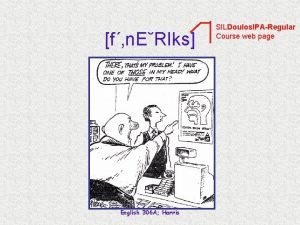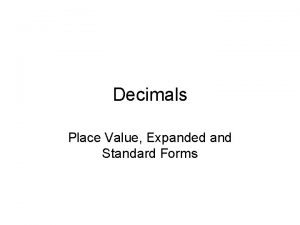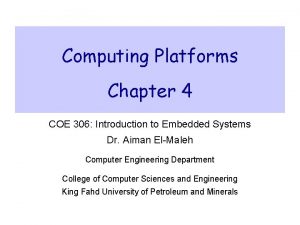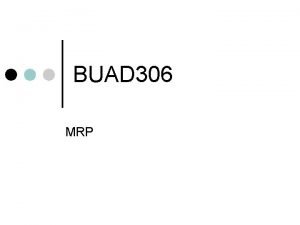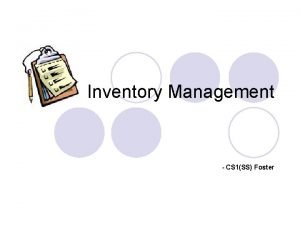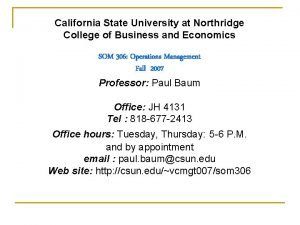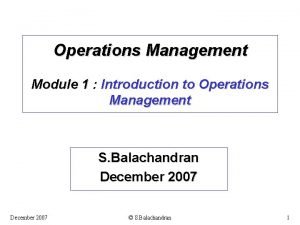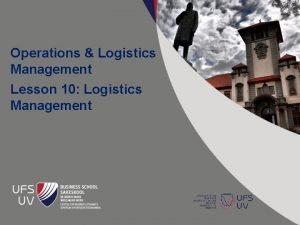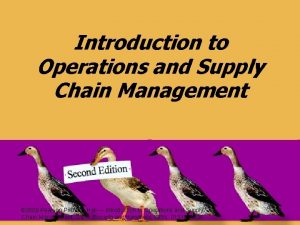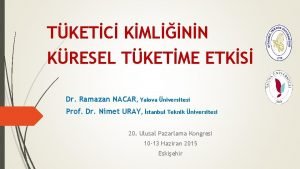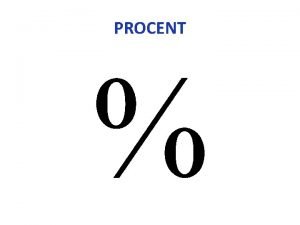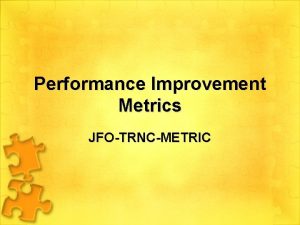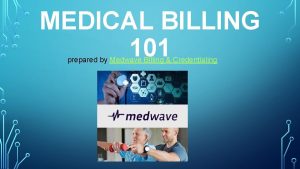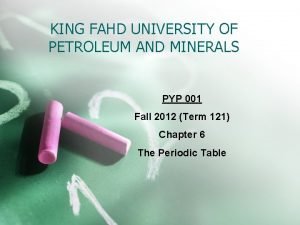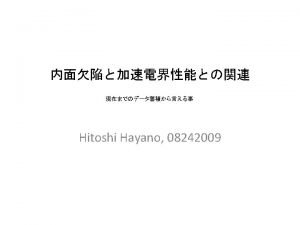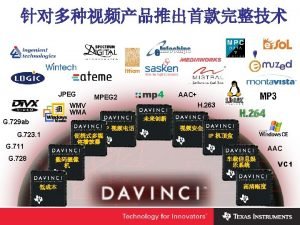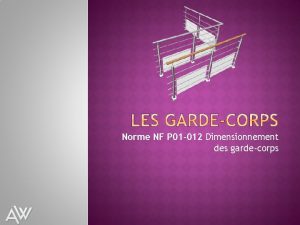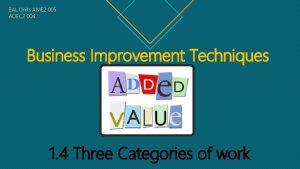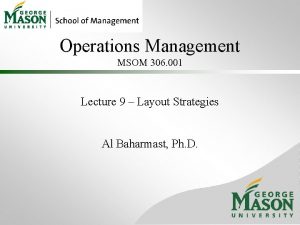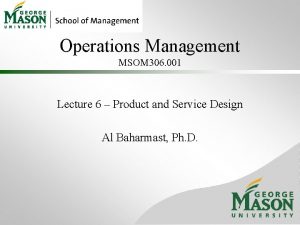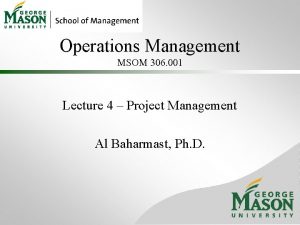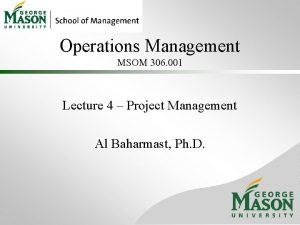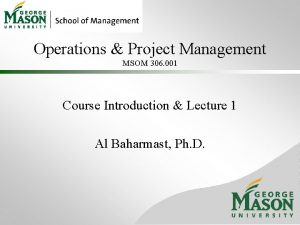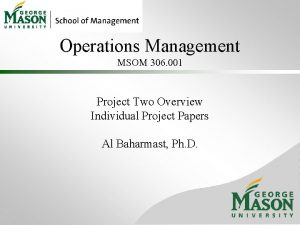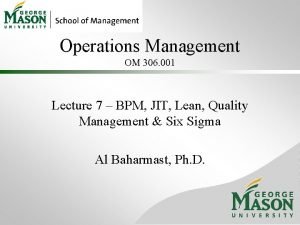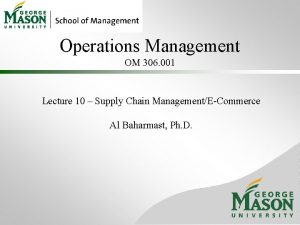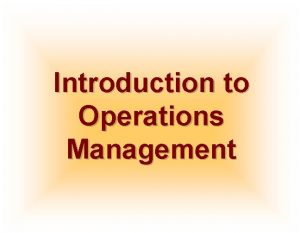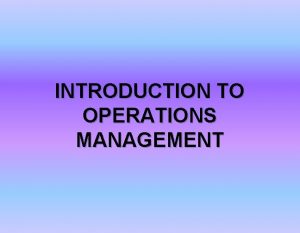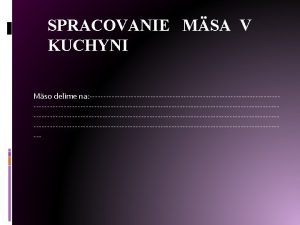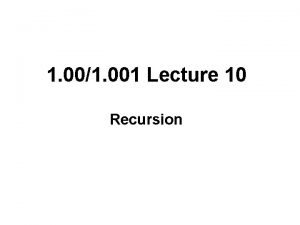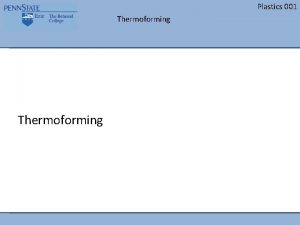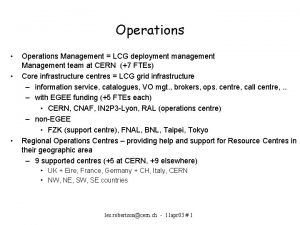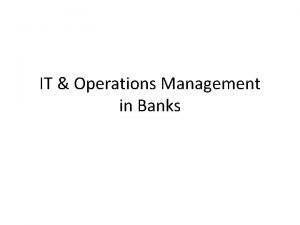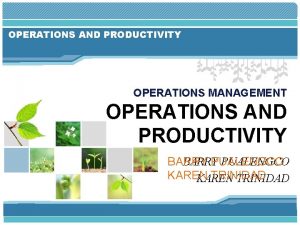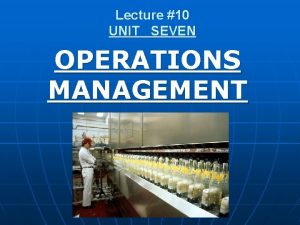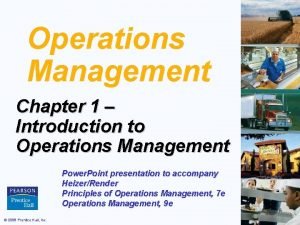Operations Management MSOM 306 001 Lecture 2 Introduction
















































- Slides: 48

Operations Management MSOM 306. 001 Lecture 2 – Introduction to Operations Management & Productivity Al Baharmast, Ph. D.

Lecture Overview Agenda • • • Mini-Case – Hard Rock Café Defining Operations Management (OM) Overview of the Value Chain and Value Network Organizational Structures Decisions in OM Jobs in OM History of OM Of Goods & Services Trends in OM The Productivity Challenge Ethics in Social Responsibility Food Fight Case Review Some lecture content courtesy of Prentice Hall, Rights Reserved

Mini-Case Hard Rock Cafe - Opened in 1971 in London by two Americans - Isaac Tigrett (age 24) and Peter Morton (age 25) - Sold their share HRC in early 1990 s for ~ $400 Million each - One of the world’s leading theme restaurants, hotels & casinos - Outputs – Food, Drink, Clothing and other Merchandise, and… Entertainment - Inputs – Food ingredients, soft drinks & alcohol, music, merchandise, labor, capital, land/property, thematic coordination (management) - 110 restaurants in 40 countries, 10 hotels in 2 countries, 5 casinos in 2 countries Some lecture content courtesy of Prentice Hall, Rights Reserved

Hard Rock Café Video Case • Operations Strategy Evolution • London restaurant based on Tennessee café • Expanding restaurant offer food with entertainment • Food with experience • All OM decision areas are important elements in the delivery of Hard Rock Experience • • • Design of Goods & Services Managing Quality Process Strategy Location Strategies Layout Strategies Human Resources Supply Chain Management Inventory Management Scheduling Maintenance Some lecture content courtesy of Prentice Hall, Rights Reserved

Hard Rock Café Video Case • Hard Rock HR Department – A True ‘Support Center’ (supporting operations) • • Inventory Management • • Kitchen flow (service optimization) and floor design (service optimization and revenue maximization) Memorabilia layout – Clapton’s Fendor to car crash doorway to Beatle’s Magical Mystery Tour bus Scheduling • • • Narrow location from Country to City to precise Street corner Location decision can have significant, long term impact Layout • • Food & Merchandise Memorabilia - $40 Million of inventory; know where the inventory is and rotate it Location • • • Train & develop employees Use prior year sales history, local events schedules, seasonality and recent sales trends to develop a sales forecast Sales forecast used to build a “production” schedule (labor, ordering, events, etc. ) Product Design & Quality • Menu reviews and food research, quality surveys, products standard and controls Some lecture content courtesy of Prentice Hall, Rights Reserved

Defining Operations Management • Production is the creation of goods and services • Operations management is the set of activities that creates goods and services by transforming inputs into outputs • Inputs are material resources, labor, capital, land property, management, energy, knowledge and technology (Factors of Production) • Outputs are value-added goods and services (finished or semi-finished) ready for consumption by a customer Some lecture content courtesy of Prentice Hall, Rights Reserved

Value Chains and Value Networks In his 1985 best-seller, Competitive Advantage: Creating and Sustaining Superior Performance, Michael Porter (Harvard Business School) posited the notion there was a general model of organization of a firm’s value-added activities Principle used by thousands of companies to break-down what they do, how they do it and how they compare with others. Critique – not the best for services and e-operations. Some lecture content courtesy of Prentice Hall, Rights Reserved

Organizational Functions Marketing • Gets customers Operations • creates product or service Finance/Accounting • Obtains funds • Tracks money © 1995 Corel Corp. Some lecture content courtesy of Prentice Hall, Rights Reserved

Functions - Bank Commercial Bank © 1984 -1994 T/Maker Co. Marketing Teller Scheduling Operations Check Clearing Transactions Processing Some lecture content courtesy of Prentice Hall, Rights Reserved Finance/ Accounting Security

Functions - Airline Marketing Flight Operations Ground Support Facility Maintenance Some lecture content courtesy of Prentice Hall, Rights Reserved © 1984 -1994 T/Maker Co. Finance/ Accounting Catering

Functions - Manufacturer Manufacturing Marketing Manufacturing Operations Production Control Quality Control Some lecture content courtesy of Prentice Hall, Rights Reserved Finance/ Accounting Purchasing

Organizational Charts Commercial Bank Operations Teller Scheduling Check Clearing Transactions processing Facilities design/layout Vault operations Maintenance Security Finance Investment s Security Real Estate Marketing Loans Commercial Industrial Financial Personal Mortgage Accounti ng Auditing Trust Department Some lecture content courtesy of Prentice Hall, Rights Reserved

Organizational Charts Airline Operations Ground support equipment Maintenance Ground Operations Facility maintenance Catering Flight Operations Crew scheduling Flying Communications Dispatching Management science Finance & Accounting Payables Receivables General Ledger Finance Cash control International exchange Some lecture content courtesy of Prentice Hall, Rights Reserved Marketing Traffic administration Reservations Schedules Tariffs (pricing) Sales Advertising

Organizational Charts Manufacturing Operations Facilities: Construction: maintenance Production & inventory control Scheduling: materials control Supply-chain management Manufacturing Tooling, fabrication, assembly Design Product development and design Detailed product specifications Industrial engineering Efficient use of machines, space, and personnel Process analysis Development and installation of production tools and equipment Finance & Accounting Disbursements/cre dits Receivables Payables General ledger Funds Management Money market International exchange Capital requirements Stock issue Bond Some lecture content courtesy of Prentice Hall, Rights Reserved issues and Marketin g Sales promotions Advertising Sales Market research

What Do Operations Managers Do? þPlanning þOrganizing þStaffing þLeading þControlling Some lecture content courtesy of Prentice Hall, Rights Reserved

Where Are the OM Jobs? Strategy development Supply and delivery Technology/methods Facilities/space utilization Response time People/team development Customer service Quality Cost reduction Inventory reduction Productivity improvement Scheduling Some lecture content courtesy of Prentice Hall, Rights Reserved

The Critical Decisions Quality management • Who is responsible for quality? • How do we define quality? Service and product design • What product or service should we offer? • How should we design these products and services? Some lecture content courtesy of Prentice Hall, Rights Reserved

The Critical Decisions - Continued Process and capacity design • What processes will these products require and in what order? • What equipment and technology is necessary for these processes? Location • Where should we put the facility • On what criteria should we base this location decision? Some lecture content courtesy of Prentice Hall, Rights Reserved

The Critical Decisions - Continued Layout design • How should we arrange the facility? • How large a facility is required? Human resources and job design • How do we provide a reasonable work environment? • How much can we expect our employees to produce? • How should they be trained? Some lecture content courtesy of Prentice Hall, Rights Reserved

The Critical Decisions - Continued Supply chain management • Should we make or buy this item? • Who are our good suppliers and how many should we have? Inventory, material requirements planning, JIT “just-in-time” inventory, • How much inventory of each item should we have? • When do we re-order? Some lecture content courtesy of Prentice Hall, Rights Reserved

The Critical Decisions - Continued Intermediate, short term, and project scheduling • Is subcontracting production a good idea? • Are we better off keeping people on the payroll during slowdowns? Maintenance • Who is responsible for maintenance? • How do we do maintenance? Some lecture content courtesy of Prentice Hall, Rights Reserved

Changing Challenges for the Operations Manager Some lecture content courtesy of Prentice Hall, Rights Reserved

Changing Challenges for the Operations Manager Some lecture content courtesy of Prentice Hall, Rights Reserved

History of Operations Management Division of labor (Adam Smith 1776 and Charles Babbage 1852) Standardized parts (Whitney 1800) Scientific Management (Taylor 1881) Coordinated assembly line (Ford, Sorenson/Avery 1913) Gantt charts (Gantt 1916) Motion study (Frank and Lillian Gilbreth 1922 Quality control (Shewhart 1924; Deming 1950) Computer (Atanasoff 1938) CPM/PERT (Du. Pont 1957) Some lecture content courtesy of Prentice Hall, Rights Reserved

History of Operations Management Material requirements planning (Orlicky 1960) Computer aided design (CAD 1970) Flexible manufacturing system (FMS 1975) Baldrige Quality Awards (1980) Computer integrated manufacturing (1990) Globalization (1992) Internet (1995) Some lecture content courtesy of Prentice Hall, Rights Reserved

Eli Whitney Born 1765; died 1825 In 1798, received government contract to make 10, 000 muskets Showed that machine tools could make standardized parts to exact specifications © 1995 Corel Corp. • Musket parts could be used in any musket Some lecture content courtesy of Prentice Hall, Rights Reserved

Frederick W. Taylor Born 1856; died 1915 Known as ‘father of scientific management’ In 1881, as chief engineer for Midvale Steel, studied how tasks were done • Began first time & motion studies Created efficiency principles © 1995 Corel Corp. Some lecture content courtesy of Prentice Hall, Rights Reserved

Frank & Lillian Gilbreth Frank (1868 -1924); Lillian (18781972) Husband-wife engineering team Further developed work measurement methods Applied efficiency methods to their home & 12 children! (Book & Movie: “Cheaper by the Dozen, ” book: “Bells on Their Toes” Some lecture content courtesy of Prentice Hall, Rights Reserved © 1995 Corel Corp.

Henry Ford Born 1863; died 1947 In 1903, created Ford Motor Company In 1913, first used moving assembly line to make Model T ‘Make them all alike!’ • Unfinished product moved by conveyor past work station Paid workers very well for 1911 ($5/day!) Some lecture content courtesy of Prentice Hall, Rights Reserved © 1995 Corel Corp.

W. Edwards Deming Born 1900; died 1993 Engineer & physicist Credited with teaching Japan quality control methods in post-WW 2 Used statistics to analyze process His methods involve workers in decisions Some lecture content courtesy of Prentice Hall, Rights Reserved

Joseph M. Juran Quality has two components – defect reduction and innovation Applied the Pareto Principle to quality movement (vital few and trivial many) Concentrated on the human aspects of quality, the value of training and education Isolated ‘resistance to change’ as central challenge to quality improvement Some lecture content courtesy of Prentice Hall, Rights Reserved

Operations Management History Took Contributions From • Industrial engineering • Management science • Biological science • Physical sciences • Information science Some lecture content courtesy of Prentice Hall, Rights Reserved

Characteristics of Goods • Tangible product • Consistent product definition • Production usually separate from consumption • Can be inventoried • Low customer interaction Some lecture content courtesy of Prentice Hall, Rights Reserved © 1995 Corel Corp.

Characteristics of Service • Produced & consumed simultaneously • Intangible product • Often unique (easy to differentiate) • High customer interaction • Inconsistent product definition • Often knowledge-based • Frequently dispersed © 1995 Corel Corp. Some lecture content courtesy of Prentice Hall, Rights Reserved

Goods Versus Services Goods • Service Can be resold • Can be inventoried • Reselling unusual • Cannot be inventoried • Some aspects of quality measurable • Selling is distinct from production • Quality difficult to measure • Selling is part of service Some lecture content courtesy of Prentice Hall, Rights Reserved

Goods Versus Services - Continued Goods • Service Product is transportable • Provider, not product is transportable • Site of facility important for cost/market access • Site of facility important for customer contact • Often easy to automate • Often difficult to automate • Revenue generated primarily from tangible/intangible product • Revenue generated primarily from intangible service Some lecture content courtesy of Prentice Hall, Rights Reserved

Goods Contain Services & Services Contain Goods Automobile Computer Installed Carpeting Fast-food Meal Restaurant Meal Auto Repair Hospital Care Advertising Agency Investment Management Consulting Service Counseling 100 75 50 25 50 75 100 Percent of Product that is a Good Percent of Product that is a Service Some lecture content courtesy of Prentice Hall, Rights Reserved

Organizations in Each Sector Service Sector Example % of all Jobs Professional Services, Education, Legal, Medical Notre Dame University, San Diego Zoo, Arnold Palmer Hospital 25. 5 Trade (retail, wholesale) Walgreen’s, Wal-Mart, Nordstrom’s 20. 6 Utilities, Transportation Pacific Gas & Electric, American Airlines, Santa Fe R. R. , Roadway Express 7. 1 Table 1. 4 Some lecture content courtesy of Prentice Hall, Rights Reserved

The Economic System Transforms Inputs to Outputs Input s Land, Labor, Capital, Manageme nt Process The economic system transforms inputs to outputs at about an annual 2. 5% increase in productivity (capital 38% of 2. 5%), (labor 10% of 2. 5%), (management 52% of 2. 5%) Feedback loop Some lecture content courtesy of Prentice Hall, Rights Reserved Outputs Goods and Services

Productivity Measure of process improvement Represents output relative to input(s) Productivity = Units produced Input used Productivity increases improve standard of living Some lecture content courtesy of Prentice Hall, Rights Reserved

Productivity Variables Productivity = Output Labor + material + energy + capital + miscellaneous • When multiple inputs are used to measure productivity, this is termed multi-factor productivity. • When one input is used to measure productivity, this is termed single factor productivity. Some lecture content courtesy of Prentice Hall, Rights Reserved

Productivity Variables Labor - contributes about 10% of the annual increase Capital - contributes about 32% of the annual increase Management - contributes about 52% of the annual increase Some lecture content courtesy of Prentice Hall, Rights Reserved

Key Variables for Improved Labor Productivity • • Basic education appropriate for the labor force Diet of the labor force Social overhead that makes labor available Maintaining and enhancing skills in the midst of rapidly changing technology and knowledge Some lecture content courtesy of Prentice Hall, Rights Reserved

Investment and Productivity in Selected Nations Some lecture content courtesy of Prentice Hall, Rights Reserved

Ethics & Social Responsibility Ethical Challenges Facing Operations Managers • Developing Safe, Quality Products • Maintaining a Clean, Sustainable Environment • Providing a Safe Workplace • Providing a Fair Wage and Benefits • Honoring Community Commitments Some lecture content courtesy of Prentice Hall, Rights Reserved

Food Fight: The Day Mc. Donald’s Blinked Mc. Donald’s background • Market leader – 26, 000 restaurants in 120 countries; 43 million customers per day; 42% market share; gross sales - $40 billion • Burger King – 11, 000 restaurants in 57 countries; 15 million customers per day; gross sales - $11 billion • Differing operations strategies – Mc. Donald’s – Quality food delivered fast – Burger King – Flexibility, Customization – ‘Have it Your Way’ Some lecture content courtesy of Prentice Hall, Rights Reserved

Mc. Donald’s ‘Made for You Campaign’ Radical departure from its Make-to-Stock philosophy (v. Make-to-Order) Cost about $25 -$80 K per store (total implementation cost – $1 billion+) Included French frying and ordering automation Cooking area layout optimization Three components • Order customization • Improved service response time • Improved quality (freshness and heat) Some lecture content courtesy of Prentice Hall, Rights Reserved

Why the Shift in Strategy? • Ten years of slow growth run up to 2000 • Competitors nibbling away at its heels • Burger King had been beating Mc. Donald’s on price; within four seconds on service speed • Wendy’s is taking market share; beating Mc. Donald’s on service speed by 17 seconds • New Strategy – Improves speed of delivery (historical competitive advantage) – Provides for customization (attacks competitor’s advantage) Some lecture content courtesy of Prentice Hall, Rights Reserved
 Om306
Om306 01:640:244 lecture notes - lecture 15: plat, idah, farad
01:640:244 lecture notes - lecture 15: plat, idah, farad National general core value plan
National general core value plan Prime factorization of 306
Prime factorization of 306 306 subject code
306 subject code How radio waves carry information
How radio waves carry information Ed 306
Ed 306 Las virtudes teologales cuales son
Las virtudes teologales cuales son Calomel electrode
Calomel electrode Paulo sentelhas e angelocci geadas aula lce 306
Paulo sentelhas e angelocci geadas aula lce 306 Paulo cesar sentelhas
Paulo cesar sentelhas Paulo sentelhas e angelocci geadas aula lce 306
Paulo sentelhas e angelocci geadas aula lce 306 306
306 306 in expanded form
306 in expanded form 306
306 Product structure tree example
Product structure tree example Buad 306
Buad 306 306 bones
306 bones Navsup form 1282
Navsup form 1282 Som 306 csun
Som 306 csun Operations management modules
Operations management modules Introduction to operations and supply chain management
Introduction to operations and supply chain management Objectives of operations management
Objectives of operations management Introduction to operations and supply chain management
Introduction to operations and supply chain management Quality management in operations management
Quality management in operations management Operations management chapter 12 inventory management
Operations management chapter 12 inventory management What is tqm
What is tqm Heterojenleşme nedir
Heterojenleşme nedir How to find t critical value
How to find t critical value 20 ppm i decimalform
20 ppm i decimalform Acad 02-001
Acad 02-001 Metasploitable ova download
Metasploitable ova download Nom 001
Nom 001 Multiplicação por 0 1 0 01 e 0 001
Multiplicação por 0 1 0 01 e 0 001 Cpt 99374
Cpt 99374 W trzech koszykach jest razem 72 jabłek
W trzech koszykach jest razem 72 jabłek Pyp-001
Pyp-001 60m height
60m height 110 000 110 111 000 111
110 000 110 111 000 111 320 dm
320 dm Etsi gs nfv-ifa 011
Etsi gs nfv-ifa 011 Semt.001
Semt.001 Write 702 001 in expanded form
Write 702 001 in expanded form Nf p01-012
Nf p01-012 Easa cm-swceh-001
Easa cm-swceh-001 In mudra loan rs.50 001 to rs.500 000 are categorised as
In mudra loan rs.50 001 to rs.500 000 are categorised as Auec2-004
Auec2-004 Ip-eng-001
Ip-eng-001 How many significant figures are in 3,000,001
How many significant figures are in 3,000,001



